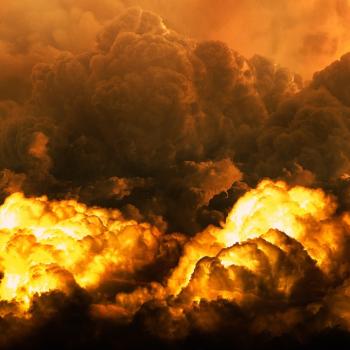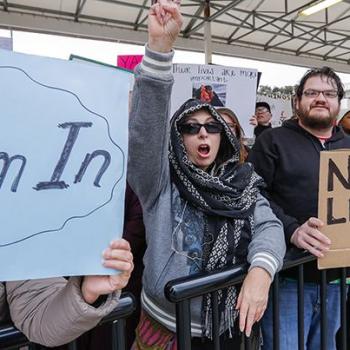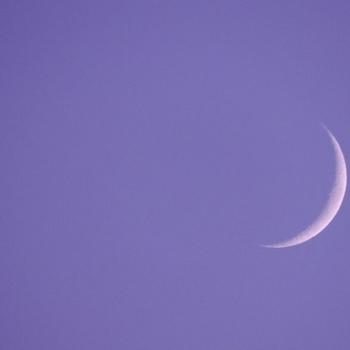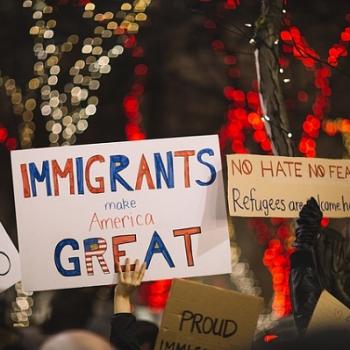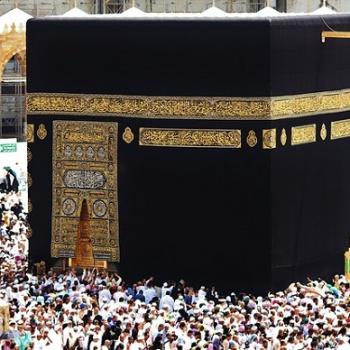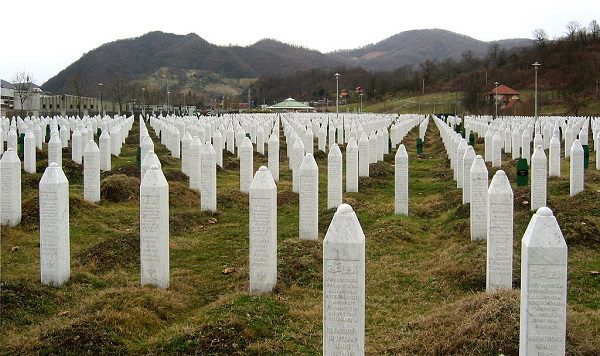
To God we belong and to God we return. Please take the time to say a prayer, for these men and boys, and also for the survivors. So many lives cut short (in the span of 3 days). It’s especially breathtaking (as in, I can’t breathe) when I see DOBs so close to my own. While I was taking exams and learning how to drive, they were murdered in cold blood, a deliberate genocide. Inna lillahi wa inna ilayhi rajioon. – Hind Makki, Patheos Muslim blogger at Hindtrospectives
Twenty years ago, like Hind, I was taking exams and navigating college life. It was a very good, carefree time for me, outside of collegiate, work and academic responsibilities. I had a roof over my head, food to eat, a car to drive and was getting an education. I was enjoying an easy Ramadan in the wintertime, breaking fast on campus with friends, driving home to pray Taraweeh with my parents. We would turn on the news post-Taraweeh to see the horror that was happening across the ocean to fellow Muslims.
Thousands of miles away, 8,000 Muslim men and boys were brutally killed in a horrible genocide, shattering the mantra of “Never Again,” which had been emphatically uttered by so many after genocides before.
I remember vividly my heart breaking 20 years ago. I was studying the Holocaust in my history class at school. At night, we would watch the news and I would see the nearly identical images of emaciated men behind barbed wire, penned in concentration camps bc [sic] of their religious identities. Only what I saw in the news wasn’t history. I vividly remember seeing footage of some of our brothers who escaped the massacre at Srebrenica by hiding in a forest and making their way toward another UN “safe zone.” I vividly remember thinking that “never again” is a lie. – Hind Makki, Facebook status update
Remembering is so, so crucial to our humanity. Remember the cruelties, horrors, genocides of the past. “Never Again” is a lie, because the Holocaust happened. Then a genocide happened in Srebrenica. And others have happened again in other parts of the world.
But “Never Forget” is something we must hold onto tight – digging our nails into a past that must not be forgotten in hopes that we can somehow do better, be better, think better, live better. And even when we fail to do that again and again, we must dig our nails in deeper.
The 20 year “anniversary” coverage of the genocide in Srebrenica (yes, I will call it a genocide) has offered many perspectives and stories worth reading, digesting, understanding and reflecting upon.
From the New York Times, this piece on “Srebrenica Revisited” tells the stories of survivors, of loved ones massacred and of horrible times, like the story of Mr. Avdic:
First, they hid in bushes as Serb paramilitaries marched another group of Muslims to slaughter. Then they resumed their flight, hiding in burned-out houses, even sleeping in a graveyard. After four days, Mr. Avdic’s wounds were infected and he could no longer even crawl. His companion carried him until, at last, they reached Tuzla.
Only a few thousand survived the “death march.” Many were killed by land mines or attacks by Serb forces. Some died of dehydration and sheer exhaustion. A few committed suicide rather than face capture by Serb forces.
To this day, there are many in Bosnia — teachers, municipal officials, police officers — who played a dark part in the mass killings of 1995. Until recently, Serb-dominated schools still proudly displayed pictures of indicted war criminals, including the Bosnian Serb politician Radovan Karadzic and the commander of the Army of Republika Srpska, Gen. Ratko Mladic. Both men are on trial in The Hague for war crimes related to the Srebrenica genocide.
Mr. Avdic lost his father, four uncles, six cousins and at least 20 other relatives in the war. Despite the horrors of Srebrenica, it was also his home, he said, and he refused to be driven from it. He returned to live there in 2007 and is now the father of two girls, ages 3 and 5.
“What kind of future do we have,” he asked, “when my children are taught by people who participated in the massacre itself?”
This article in The Guardian discusses the West’s involvement in the lead-up to the fall of Srebrenica, revealing classified documents and research showing British, American and French governments negotiating to “cede ‘safe area’ town to Serbs.”
Eight thousand Bosnian Muslim men and boys were killed over four days in July 1995 by Bosnian Serb death squads after they took the besieged town, which had been designated a “safe area” under the protection of UN troops. The act has been declared a genocide by the war crimes tribunal in The Hague, and the Bosnian Serb leaders Radovan Karadžic and General Ratko Mladic await verdicts in trials for directing genocide.
Blame has also been placed on Dutch troops, who evicted thousands seeking refuge in their headquarters, and watched while the Serbs separated women and young children from their male quarry.
But a new investigation of the mass of evidence documenting the siege suggests much wider involvement in the events leading to the fall of Srebrenica. Declassified cables, exclusive interviews and testimony to the tribunal show that the British, American and French governments accepted – and sometimes argued – that Srebrenica and two other UN-protected safe areas were “untenable” long before Mladic took the town, and were ready to cede Srebrenica to the Serbs in pursuit of a map acceptable to the Serbian president, Slobodan Miloševic, for peace at any price.
This sobering infographic shows the faces of thousands who died. As you scroll over the faces, you can click to see the victim’s names and ages.
And finally, the Day 24 post by Arnesa Buljusmic-Kustura for the “Hindtrospectives” series on women’s mosque and Ramadan experiences talks about a Ramadan of war – Arnesa’s first time fasting in Bosnia in the winter of 1995, when the war had reached its. Peak. Please stop a minute and read this short and powerful reflection:
That month, I prayed my first taraweeh in the cold basement of a building that before the war might have been a store. It was converted by the people in my neighborhood into a masjid for the month of Ramadan. The building was cold and damp and the people were crowded together for taraweeh and being the only child, I stood out like a sore thumb. My grandmother, who would bring me with her, would receive a scolding from the elders each night for bringing me during such a dangerous time.
But, I did not fear. I figured if I was to be killed it may as well be in a masjid. Besides, I found solace in the way the imam’s prayers echoed throughout the building, growing louder with each word, almost fighting against the shelling. There was something peaceful in the imam’s recitation of the adhan in the midst of the misery that was Sarajevo in 1995. It was during these nights in our little masjid that I found hope.
After every taraweeh, I would make a dua for the shelling and the snipers to stop. I would picture my life as it should have been for a child; carefree with chocolates, toys, and Disney movies and I would beg God to end our suffering. My little masjid became my sanctuary and every step I took towards it and away from the sound of shelling was a step towards sanity.
These are horrible times in our history that we must not forget. Out of them comes stories of utter horror, despair and death, as well as stories of hope, resistance determination and faith. In these last ten days of Ramadan, please pray for our world’s humanity, for “Never Forget” and “Never Again.” If you are of a different faith or not of any faith at all, please still join in these thoughts.




